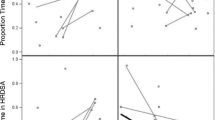Abstract
Aberrant attention is a core feature of fragile X syndrome (FXS), however, little is known regarding the developmental trajectory and underlying physiological processes of attention deficits in FXS. Atypical visual attention is an early emerging and robust indictor of autism in idiopathic (non-FXS) autism. Using a biobehavioral approach with gaze direction and heart activity, we examined visual attention in infants with FXS at 9, 12, and 18 months of age with a cross-sectional comparison to 12-month-old typically developing infants. Analyses revealed lower HR variability, shallower HR decelerations, and prolonged look durations in 12-month old infants with FXS compared to typical controls. Look duration and increased latency to disengage attention were correlated with severity of autistic behavior but not mental age.




Similar content being viewed by others
References
Bailey, D. B., Jr., Raspa, M., Holiday, D., Bishop, E., & Olmsted, M. (2009). Functional skills of individuals with fragile X syndrome: A lifespan cross-sectional analysis. American Journal on Intellectual and Developmental Disabilities, 14, 289–303.
Bornstein, M. H. (1998). Stability in mental development from early life: Methods, measures, models, meanings, and myths. In F. Simion & G. Butterworth (Eds.), The development of sensory, motor and cognitive capacities in early infancy: From perception to cognition (pp. 301–332). Hove, England/Erlbaum, UK: Psychology Press/Taylor & Francis.
Bryson, S. E., Czapinski, P., Landry, R., McDonnel, B., Rombough, V., & Wainwright, A. (2004). Autistic spectrum disorders: Causal mechanisms and recent findings on attention and emotion. International Journal of Special Education, 19, 14–22.
Bryson, S. E., Rogers, S. J., & Fombonne, E. (2003). Autism spectrum disorders: Early detection, intervention, education, and psychopharmacological management. Canadian Journal of Psychiatry, 48, 506–516.
Cohen, I. L. (1995). A theoretical analysis of the role of hyperarousal in the learning and behavior of fragile X males. Mental Retardation and Developmental Disabilities, 1(4), 286–291.
Colombo, J., Kannass, K. N., Shaddy, D. J., Kundurthi, S., Maikranz, J. M., Anderson, C. J., et al. (2004). Maternal DHA and the development of attention in infancy and toddlerhood. Child Development, 75, 1254–1267.
Courage, M. L., Reynolds, G. D., & Richards, J. E. (2006). Infants’ attention to patterned stimuli: Developmental change from 3 to 12 months of age. Child Development, 77, 680–695.
Dombrowski, C., Lévesque, S., Morel, M. L., Rouillard, P., Morgan, K., & Rousseau, F. (2002). Premutation and intermediate-size FMR1 alleles in 10572 males from the general population: Loss of an AAG interruption is a late event in the generation of fragile X syndrome alleles. Human Molecular Genetics, 11, 371–378.
Elsabbagh, M., Volein, A., Holmboe, K., Tucker, L., Csibra, G., Baron-Cohen, S., et al. (2009). Visual orienting in the early broader autism phenotype: Disengagement and facilitation. Journal of Child Psychological Psychiatry, 50, 637–642.
Goldsmith, H. H., & Rothbart, M. K. (1996). The laboratory temperament assessment battery (LAB-TAB). Madison, WI: University of Wisconsin.
Goldsmith, H. H., & Rothbart, M. K. (1999). The laboratory temperament assessment battery (LAB-TAB, Prelocomotor Version, Edition 3.1). Madison, WI: University of Wisconsin Press.
Hagerman, R. J. (2002). Medical follow-up and pharmacotherapy. In R. J. Hagerman & P. J. Hagerman (Eds.), Fragile X syndrome: Diagnosis, treatment, and research (pp. 287–338). Baltimore, MD: Johns Hopkins University Press.
Hagerman, R. J. (2008). Etiology, diagnosis, and development in fragile X syndrome. In J. E. Roberts, R. S. Chapman, & S. F. Warren (Eds.), Speech and language development and intervention in Down syndrome and fragile X syndrome (pp. 27–49). Baltimore, MD: Paul H Brookes Publishing.
Hagerman, R. J., Berry-Kravis, E., Kaufmann, W. E., Ono, M. Y., Tartaglia, N., Lachiewicz, A., et al. (2009). Advances in the treatment of fragile X syndrome. Pediatrics, 123, 378–390.
Hall, S. S., Lightbody, A. A., Huffman, L. C., Lazzeroni, L. C., & Reiss, A. L. (2009). Physiological correlates of social avoidance behavior in children and adolescents with fragile X syndrome. Journal of the American Academy of Child and Adolescent Psychiatry, 48(3), 320–329.
Hall, S. S., Lightbody, A. A., & Reiss, A. L. (2008). Compulsive, self-injurious, and autistic behavior in children and adolescents with fragile X syndrome. American Journal on Mental Retardation, 113, 44–53.
Harris, S. W., Hessl, D., Goodlin-Jones, B., Ferranti, J., Bacalman, S., Barbato, I., et al. (2008). Autism profiles of males with fragile X syndrome. American Journal on Mental Retardation, 113, 427–438.
Johnson, C. P., & Myers, S. M. (2007). Identification and evaluation of children with autism spectrum disorders. Pediatrics, 120, 1183–1215.
Kaufmann, W. E., Cortell, R., Kau, A. S., Bukelis, I., Tierney, E., Gray, R. M., et al. (2004). Autism spectrum disorder in fragile X syndrome: Communication, social interaction, and specific behaviors. American Journal of Medical Genetics A, 129A, 225–234.
Kogan, M. D., Blumberg, S. J., Schieve, L. A., Boyle, C. A., Perrin, J. M., Ghandour, R. M., et al. (2009). Prevalence of parent-reported diagnosis of autism spectrum disorder among children in the US, 2007. Pediatrics, 124, 1395–1403.
Landa, R., & Garret-Mayer, E. (2006). Development in infants with autism spectrum disorders: A prospective study. Journal of Child Psychological Psychiatry, 47, 629–638.
Merin, N., Young, G. S., Ozonoff, S., & Rogers, S. J. (2007). Visual fixation patterns during reciprocal social interaction distinguish a subgroup of 6-month-old infants at-risk for autism from comparison infants. Journal of Autism and Developmental Disorders, 37, 108–121.
Mini-Logger 2000. (1994). Computer software. Sunriver, OR: Mini Mitter Co., Inc.
Mullen, E. M. (1995). Mullen scales of early learning: AGS edition. San Antonio, TX: Pearson.
Richards, J. E. (1987). Infant visual sustained attention and respiratory sinus arrhythmia. Child Development, 58, 488–496.
Richards, J. E., & Casey, B. J. (1991). Heart rate variability during attention phases in young infants. Psychophysiology, 28(1), 43–53.
Richards, J. E., & Turner, E. D. (2001). Extended visual fixation and distractibility in children from six to twenty-four months of age. Child Development, 72(4), 963–972.
Rivera, S. M., Menon, V., White, C. D., Glaser, B., & Reiss, A. L. (2002). Functional brain activation during arithmetic processing in females with fragile X syndrome is related to FMR1 protein expression. Human Brain Mapping, 16, 206–218.
Roberts, J. E., Boccia, M. L., Bailey, D. B., Jr., Hatton, D. D., & Skinner, M. (2001). Cardiovascular indices of physiological arousal in boys with fragile X syndrome. Developmental Psychobiology, 39, 107–123.
Roberts, J. E., Boccia, M. L., Hatton, D. D., Skinner, M. L., & Sideris, J. (2006). Temperament and vagal tone in boys with fragile X syndrome. Journal of Developmental Behavior Pediatrics, 27, 193–201.
Roberts, J. E., McDonald, L., Kelleher, B. L., & Shinkareva, S. (2010). Heart activity and autistic behavior in infants with fragile X syndrome. In J. E. Roberts (Chair), Detection and effect of autism on infants and preschoolers with fragile X syndrome. Symposium conducted at the 42nd annual Gatlinburg conference on research and theory in intellectual and developmental disabilities, Annapolis, MD.
Scerif, G., Cornish, K., Wilding, J., Driver, J., & Karmiloff-Smith, A. (2004). Visual search in typically developing toddlers and toddlers with Fragile X or Williams syndrome. Developmental Science, 7, 116–130.
Scerif, G., Karmiloff-Smith, A., Campos, R., Elsabbagh, M., Driver, J., & Cornish, K. (2005). To look or not to look? Typical and atypical development of oculomotor control. Journal of Cognitive Neuroscience, 17, 591–604.
Schopler, E., Reichler, R. J., & Renner, B. R. (1988). Childhood autism rating scale. Los Angeles: Western Psychological Services.
Shanahan, M. A., Pennington, B. F., Yerys, B. E., Scott, A., Boada, R., Willcutt, E. G., et al. (2006). Processing speed deficits in attention deficit/hyperactivity disorder and reading disability. Journal of Abnormal Child Psychology, 34(5), 584–601.
Sudhalter, V., & Belser, R. C. (2001). Conversational characteristics of children with fragile X syndrome: Tangential language. American Journal on Mental Retardation, 106(5), 389–400.
Sullivan, K., Hatton, D., Hammer, J., Sideris, J., Hooper, S., Ornstein, P., et al. (2006). ADHD symptoms in children with FXS. American Journal of Medical Genetics A, 140, 2275–2288.
Zingerevich, C., Greiss-Hess, L., Lemons-Chitwood, K., Harris, S. W., Hessl, D., Cook, K., et al. (2009). Motor abilities of children diagnosed with fragile X syndrome with and without autism. Journal of Intellectual Disability Research, 53, 11–18.
Zwaigenbaum, L., Bryson, S., Rogers, T., Roberts, W., Brian, J., & Szatmari, P. (2005). Behavioral manifestations of autism in the first year of life. International Journal of Developmental Neuroscience, 23, 143–152.
Acknowledgments
This study was supported by the National Institute of Child Health and Human Development (P30-HD003110-35S1) and the office of Special Education Programs, US Department of Education (H324C990042).
Author information
Authors and Affiliations
Corresponding author
Rights and permissions
About this article
Cite this article
Roberts, J.E., Hatton, D.D., Long, A.C.J. et al. Visual Attention and Autistic Behavior in Infants with Fragile X Syndrome. J Autism Dev Disord 42, 937–946 (2012). https://doi.org/10.1007/s10803-011-1316-8
Published:
Issue Date:
DOI: https://doi.org/10.1007/s10803-011-1316-8




